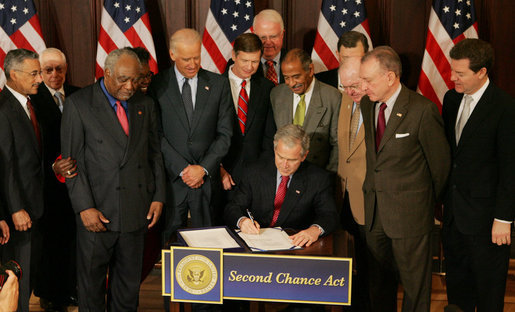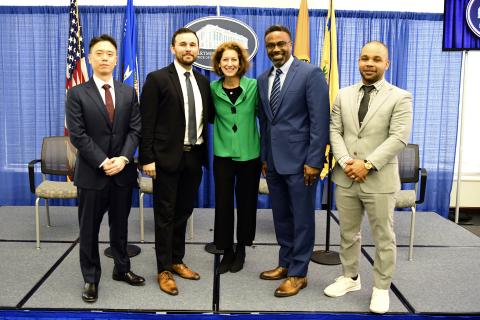From 1990 to 1999, the incarcerated population in the United States almost doubled with nearly 1.9 million people in custody in 1999 compared to 1.1 million in 1990.
This trend prompted Attorney General Janet Reno to call for new approaches in reentry with more Americans than ever leaving incarceration to return to their communities.
The National Institute of Justice responded by launching reentry partnerships and a reentry court initiative in the following years.
The federal push for enhanced reentry programs continued under President George W. Bush. In his 2004 State of the Union Speech, President Bush described America as “the land of second chance, and when the gates of the prison open, the path ahead should lead to a better life.”
A few years later – in April 2008 – Congress passed the Second Chance Act, a federal investment in reentry strategies to reduce recidivism, increase public safety and reduce corrections costs for state and local governments.
The Second Chance Act was passed with bipartisan support and backed by leaders in law enforcement, corrections, courts, behavioral health and other areas. President Bush signed the Second Chance Act into law on April 9, 2008.
What is the Second Chance Act?
The Second Chance Act authorized federal grants to government agencies and nonprofit organizations to provide reentry services and programs.
Second Chance policies aim to remove the barriers returning citizens face in reentry and improve their participation in the economy. As a result, Second Chance programs can enhance public safety by breaking the cycle of criminal recidivism and improving outcomes for people returning from prisons, jails and juvenile facilities.
Over the years, Second Chance initiatives have provided employment training and assistance, substance use treatment, education, housing, family programming, mentoring, victims support and more. Second Chance funding has also been used to support general criminal justice system improvements.
How the Office of Justice Programs is involved
Under the Second Chance Act, the Bureau of Justice Assistance and Office for Juvenile Justice and Delinquency Prevention fund reentry projects. NIJ supports evaluations on the effectiveness of Second Chance programs.
Second Chance grantees provide vital services to make a person’s transition from prison or jail safer and more successful.
Since 2009, OJP has awarded more than 1,100 Second Chance Act grants to fund adult and youth reentry programs. Overall, more than $600 million has been allocated to BJA to support Second Chance programs.
Between FY2010-22, NIJ awarded approximately $17 million for Second Chance-related research.
OJJDP Second Chance programs have provided funding, training and education for juvenile justice reentry programs. Additional OJP Second Chance programs have also supported the improvement of corrections and supervision practices that aim to reduce recidivism.
Second Chance over the years
In the first year of Second Chance – fiscal year 2009 – Congress appropriated $25 million for Second Chance programs. This initial round of funding was divided among four grant programs, including adult mentoring, reentry, juvenile mentoring and juvenile demonstration. Initial Second Chance funds also supported the establishment of the National Reentry Resource Center.
The Second Chance Pell Initiative was established in 2015 to provide Pell Grants to incarcerated individuals participating in postsecondary education programs.
In 2017, April was designated as Second Chance Month to help individuals, communities and agencies across the country recognize the importance of reentry and their role in supporting individuals leaving incarceration.
The following year, the Second Chance Act was reauthorized as part of the First Step Act in 2018.
Second Chance Fellows
Recognizing that no one understands the challenges of reentry better than those who have experienced it firsthand, the Department of Justice announced Daryl Atkinson as the first-ever Second Chance Fellow in 2015.
Second Chance Fellows are formerly incarcerated individuals with extensive reentry policy and practice expertise.
Providing a valuable perspective on reentry policies, Second Chance Fellows serve as advisors to BJA’s Second Chance portfolio during their fellowship. They collaborate with BJA and DOJ staff to provide critical outreach, data, research and subject matter expertise that informs new strategies, policies and programs to benefit the field.
In 2022, BJA welcomed two new Second Chance Fellows – John Bae and Angel Sanchez – as part of the BJA Visiting Fellows Program, and a third, Stanley Frankart, joined in 2023.
The Impact of Second Chance Programs
Since the Second Chance Act was passed in 2008, jurisdictions and local communities around the country have improved their reentry strategies.
BJA Second Chance Act grants have provided education, substance use treatment, job placement, vocational training and other services to more than 386,000 people.
From FY 2009-2022, over half of all participants enrolled in Second Chance employment, housing, and education services gained employment, obtained housing or received a higher education.
NIJ-supported research has found Second Chance funds were important in expanding grantee capacity for reentry services. Studies have shown individuals receiving services were significantly more likely to have a reentry plan and a case manager whom they trusted.
In 2024, a BJA-sponsored report found that state-level reincarceration rates have dropped since the Second Chance Act was passed. According to the report, 27 percent of people exiting prison in 2019 were reincarcerated within 3 years compared to 35 percent in 2008.





